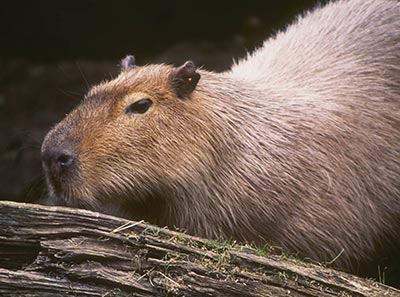| Quick Facts | |
|---|---|
| Name Meaning: | Master of the Grasses |
| Length: | 4.5 ft. |
| Weight | 150 lbs. |
| Region: | South America |
| Habitat: | Wetlands |
| Diet: | Herbivore |
| Conservation Status: | Least Concern (LC) |
| Linnaean Classification | |
| Kingdom: | Animalia |
| Phylum: | Chordata |
| Subphylum: | Vertebrata |
| Class: | Mammalia |
| Order: | Rodentia |
| Suborder: | Hystricomorpha |
| Family: | Caviidae |
| Subfamily: | Hydrochoerinae |
| Genus: | Hydrochoerus |
| Species: | Hydrochoerus hydrochaeris |
Capybara
The Capybara is the largest existing rodent in the world. It is distantly related to the guinea pig or the chinchillas. They have heavy stocky bodies and sandy-brown fur which can often become very coarse. They average about 4.5 ft long and approximately 150 lb, though some have known to be larger than this, and often the females are heavier than the males. Their feet are slightly webbed and they have no tail. They have about 20 teeth. Due to the fact that their hind legs are longer than their front legs their backs slope upward towards the rear. The ears are located on the top of their head pointing upward.
History
The name Capybara is derived from the word Kapiyva in the indigenous language of Guarani. Its Portuguese name is similar, Capivara, and the Spanish name is Carpincho. Once, a larger species of Capybara existed which has since become extinct. However, this does not mean the Capybara of today is endangered, far from it. Its ability to breed rapidly has allowed the Capybara population to remain stable. Regardless it is often hunted for its meat and in some places considered a delicacy. The skin is also used to make a high quality leather. It is sometimes used as a pet or as a farming animal.Lifestyle
It is usually about a week after birth that a Capybara is ready to eat grass, however they are not fully weaned until about 4 months afterward. Sexual maturity is attained at about 22 months. The full lifespan of the Capybara can extend from 4-8 years in the wild and can reach as old as 12 in captivity. They are frequently hunted by other tropical predators like the puma and anaconda. Their coarse hair encourages sunburn so they will often be seen rolling in mud or submersed in water to protect themselves. They are semi-aquatic, good swimmers, and can even sleep underwater with just the nose sticking out. Therefore they are often drawn to the swamps, ponds, marshes, and tropical areas of South America. Capybara are herbivores living primarily off of grass and other aquatic plants as well as some fruits. Much of their diet consists of only a few species of plant. Capybara travel in large groups for the most part, in groups of 10 or more and can sometimes be seen in groups of up to 100. They can communicate through a variety of sounds including clicking, barking, and purring.
ScienceViews Writer: Jason Hamilton.
Copyright © 2005-2010 Calvin & Rosanna Hamilton. All rights reserved.
